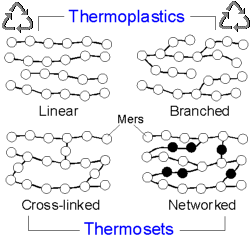 The molecular structure of polymers can be linear, branched, cross-linked or networked (highly cross-linked). Thermoplastics have either a linear or branched structure. Thermoplastics soften upon heating and harden when cooled, without ever changing the material properties. This permits the recycling of thermoplastic scraps. Cross-linked polymers are called thermosets. When heated a thermoset remains relatively hard and can not be reprocessed without chemical degradation.
The molecular structure of polymers can be linear, branched, cross-linked or networked (highly cross-linked). Thermoplastics have either a linear or branched structure. Thermoplastics soften upon heating and harden when cooled, without ever changing the material properties. This permits the recycling of thermoplastic scraps. Cross-linked polymers are called thermosets. When heated a thermoset remains relatively hard and can not be reprocessed without chemical degradation.
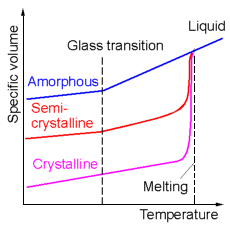 Crystalline materials exhibit a sharp change in the specific volume (inverse of density) at their melting temperature. The density of pure amorphous materials changes at the glass transition temperature. This entails significant changes in mechanical properties. Generally below this temperature polymers are stiff and brittle, while above it they act flexible and ductile. Semicrystalline polymers exhibit an intermediate behavior which includes a defined melting temperature and slight change in density at the glass transition temperature. For thermoplastics and thermosets the glass transition temperature is above the ambient temperature while for elastomers the glass transition temperature is below room temperature. Elastomers can undergo large deformation (up to several hundred percent) and recover in shape and size upon removal of the load.
Crystalline materials exhibit a sharp change in the specific volume (inverse of density) at their melting temperature. The density of pure amorphous materials changes at the glass transition temperature. This entails significant changes in mechanical properties. Generally below this temperature polymers are stiff and brittle, while above it they act flexible and ductile. Semicrystalline polymers exhibit an intermediate behavior which includes a defined melting temperature and slight change in density at the glass transition temperature. For thermoplastics and thermosets the glass transition temperature is above the ambient temperature while for elastomers the glass transition temperature is below room temperature. Elastomers can undergo large deformation (up to several hundred percent) and recover in shape and size upon removal of the load.
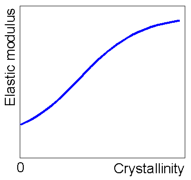 A slow cooling rate results in a high degree of crystallinity for semicrystalline polymers. The degree of crystallinity influences mechanical properties. The elastic modulus of the crystalline phase is sufficiently higher than that of the amorphous phase. In general, the higher crystallinity, the higher the elastic modulus and strength of the material.
A slow cooling rate results in a high degree of crystallinity for semicrystalline polymers. The degree of crystallinity influences mechanical properties. The elastic modulus of the crystalline phase is sufficiently higher than that of the amorphous phase. In general, the higher crystallinity, the higher the elastic modulus and strength of the material.
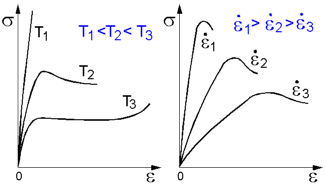 Mechanical properties of thermoplastic polymers strongly depend on the test temperature and strain rate. The polymer becomes softer and more ductile with increasing temperature. In general, strain rate decrease has the same effect on the stress-strain behavior as temperature increase.
Mechanical properties of thermoplastic polymers strongly depend on the test temperature and strain rate. The polymer becomes softer and more ductile with increasing temperature. In general, strain rate decrease has the same effect on the stress-strain behavior as temperature increase.
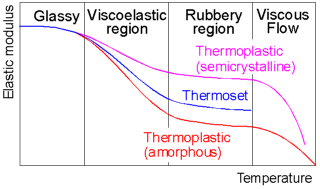 The effect of temperature on the mechanical behavior of polymers differs for thermoplastics and thermosets. Thermosets do not exhibit viscous flow. They are known to degrade and decompose at high temperature.
The effect of temperature on the mechanical behavior of polymers differs for thermoplastics and thermosets. Thermosets do not exhibit viscous flow. They are known to degrade and decompose at high temperature.
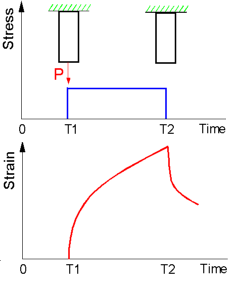 The viscoelastic behaviour is peculiar to amorphous polymers above the glass transition temperature. There is no immediate response in deformation on the applied stress. Viscoelastic deformation is a combination between the viscous deformation of liquid and elastic deformation of solid.
The viscoelastic behaviour is peculiar to amorphous polymers above the glass transition temperature. There is no immediate response in deformation on the applied stress. Viscoelastic deformation is a combination between the viscous deformation of liquid and elastic deformation of solid.
 2015-08-13
2015-08-13 467
467








